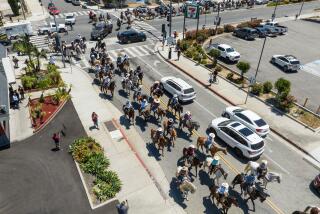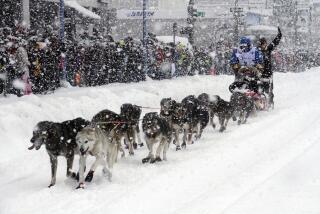Thousands Turn Out to Pull for the Mules at Bishop Celebration
- Share via
BISHOP — At the starter’s signal, the two mule skinners shouted “Git up! Hi! Up!” sending their six-mule teams lunging into the harnesses, straining to move the 18-wheel truck-trailer rigs.
One of the wackiest pulling contests ever was under way, a drag race to see which of the old-fashioned mule teams could haul a 10-ton rig across the finish line first at the 16th annual Mule Days Celebration here over the Memorial Day weekend.
Thousands of fans cheered the teams on. These were “mule people,” and they had come from all over the West to watch and participate in what has become the biggest mule show of its kind in the country.
For four days each year, these long-eared, stubborn creatures are kings in this picturesque little town on the east flank of the Sierra Nevada, 270 miles north of Los Angeles. Even traffic on U.S. 395 was rerouted as they paraded by on Saturday because the highway is the town’s main street.
Scores of packers come out of the mountains for the annual affair, bringing their strings of freight-hauling and dude-packing mules. The show also attracts mule equestrians and breeders from as far away as Missouri.
At the Inyo County Fair Grounds the grandstand and bleachers, which hold about 3,500 people, were full from early morning to well past dark as breeders, packers, riders and show people put their mules through their paces, competing for prize ribbons, trophy buckles and just for the fun of it.
The show is a three-ring circus, Western style. In the center arena a pinto mule bucks off its rider as he tries to herd cattle, while in a nearby arena a woman rider eases her docile black mule through the obstacles--gates and bridges--in the Western pleasure class.
But the big event, both for the crowd and the mule packers in the big hats, was Sunday afternoon’s “packing scramble,” which saw 16 teams of packers and their strings of mules--165 head of stock in all--in one arena at the same time.
The idea behind the “scramble” is to see which of the four-person pack teams--women compete as well as men--is the quickest and best. Before the contest begins, the mules are unsaddled and stampeded through the arena. When the starting gun goes off, each team must catch its own mules, resaddle and pack the loads and then race for the finish line, all without getting run over by somebody else’s stampeding stock.
The scramble is squarely in the tradition of Mule Days as they were first staged, back in 1970, when packer Bob Tanner of nearby Reds Meadow and Herb London of Rock Creek, decided that someone ought to start taking notice of mules, and of course, of Bishop as well.
The Bishop Chamber of Commerce thought that was a good idea and sponsored the event. In those first years, the competition centered on packing contests, “who could throw (tie) the fastest diamond (the hitch used to lash down a pack load) or shoe a mule the fastest,” Tanner explained.
The contestants were the men and women who worked the high mountain trails, hauling tourists on vacation or carrying equipment and supplies to trail crews or construction projects, the same way as the pioneers did a century ago.
Mule Packers Outnumbered
But since 1970, mules have become popular in cities. And this year the show people outnumbered the mule packers. Nearly 400 mules of all sizes and shapes were entered in Western and English competitive riding and jumping classes, as well as the more traditional Wild West Mule Days skill contests.
And this year the show people came to prove that mules can do anything horses can do, and do it better, causing one crusty young mule skinner to quip: “Those people think a mule is just a horse with long ears.”
Mules, in fact, are a hybrid cross between a jackass (a male donkey) and a female horse. The resulting colt is usually sterile. For centuries mules have been bred for size and strength as beasts of burden.
Where the ass--also known as a burro--conjures up images of Death Valley and the one-blanket prospectors seeking gold, the mule’s image is linked by heavy traces and chains to the 20-mule teams of borax fame.
In those early days, Bishop was a major transportation hub. Out of here wagon loads of supplies were hauled by teams of mules, and pack strings went into the high country, supplying the mines. When roads were built and trucks came on the scene, use of mules declined.
Mules were little seen until the early 1970s, when they began to make a comeback as recreational users began to breed and train them. Today, the American Mule Assn. promotes and regulates the expanding interest in mules.
Promotional Hobby
And people, such as trucking company operator Sam Smiser, 69, went into the mule business as a promotional hobby. At this year’s Mule Days, Smiser’s team competed against Tanner’s team in the truck-pulling contest. They split the contest, each winning one race.
But it isn’t just packers and truckers who are interested in mules. Weekend hobbyists, such as Gary and Judy Rose of Escalon, have gotten to be mule people in a big way. Gary, a Livermore fireman, and Judy, a machinist, now run Sweetwater Ranch, a five-acre spread with half a dozen mules.
“My wife, who is as stubborn as a mule, got interested in these animals and decided to prove that, with kind, gentle training, there was no reason they couldn’t do anything a horse could do,” Rose explained.
The proof of her thesis, Rose said, is Sweetwater Lavern, a mare mule that won the Monterey All Breed Challenge Cup this year, competing against purebred horses in English riding, with two jumps, Western and English pleasure classes and trail riding.
She was at Bishop, putting Sweetwater Lavern through her paces, winning more ribbons.
And the Roses’ 12-year-old daughter, Loni, dressed in English riding attire, won a first place in the halter class with her 2-year-old fawn-colored mule, Sweetwater Fortune Cookie.
More to Read
Sign up for Essential California
The most important California stories and recommendations in your inbox every morning.
You may occasionally receive promotional content from the Los Angeles Times.













